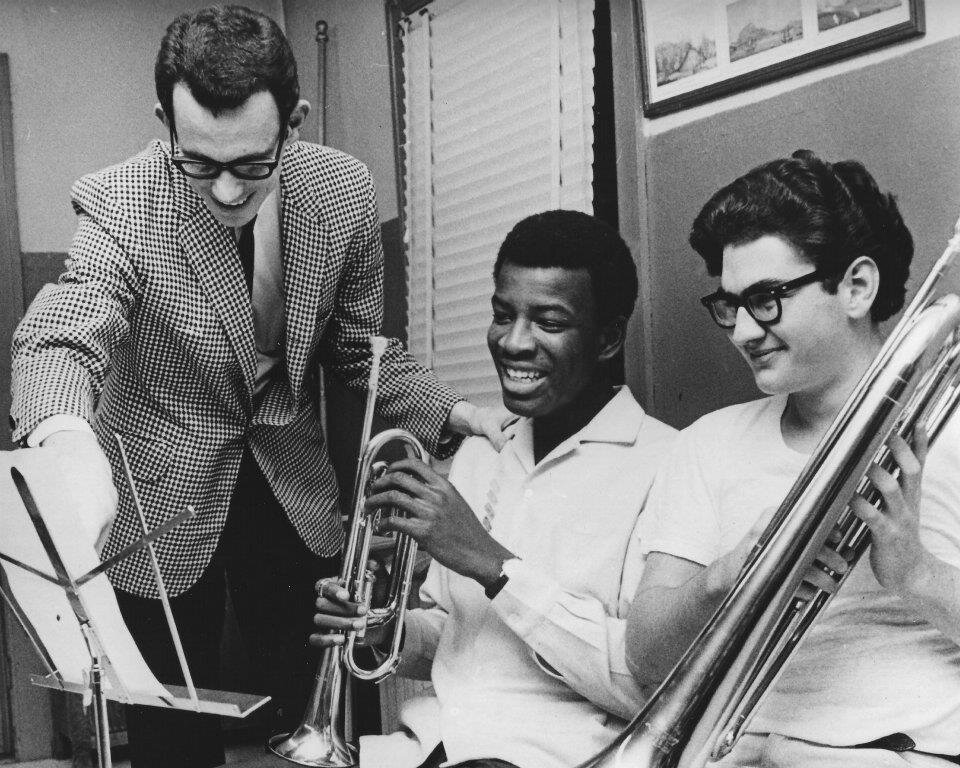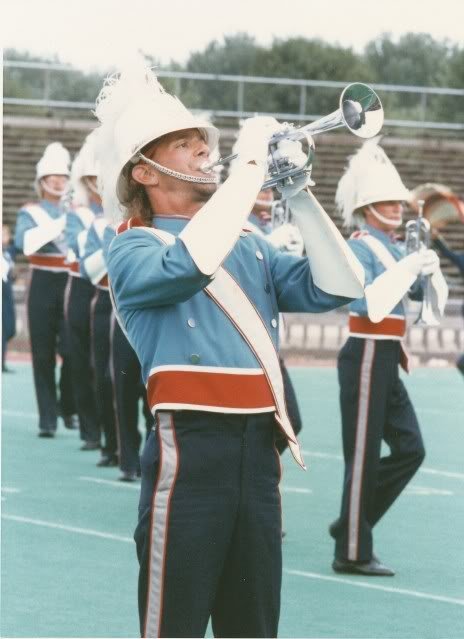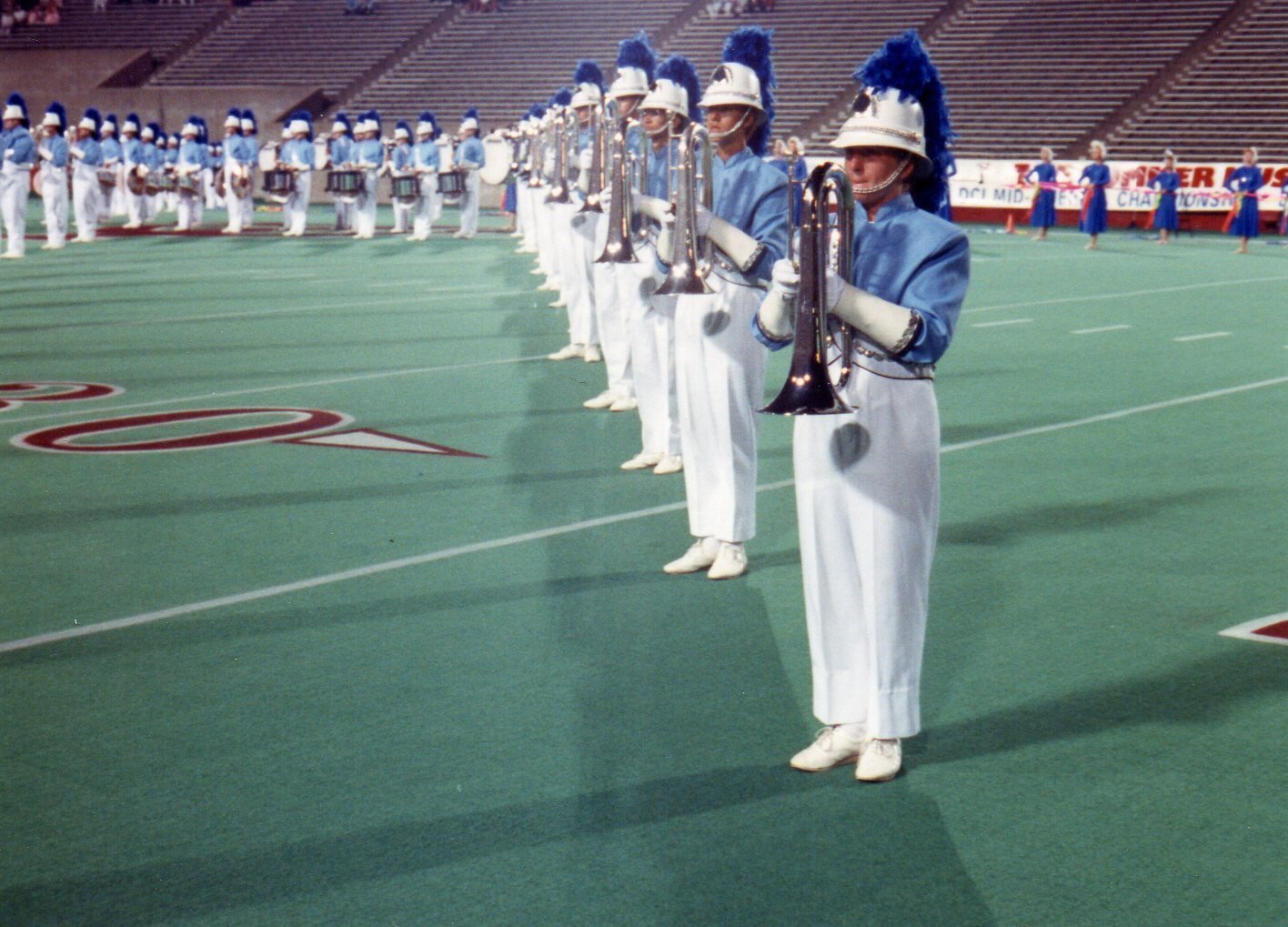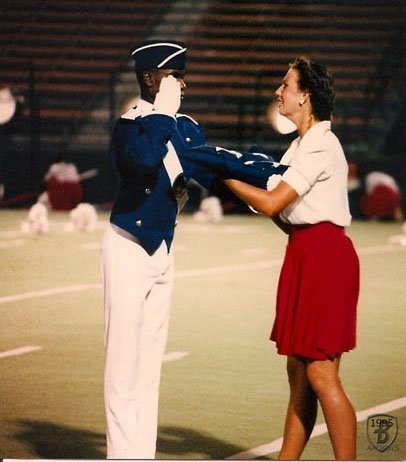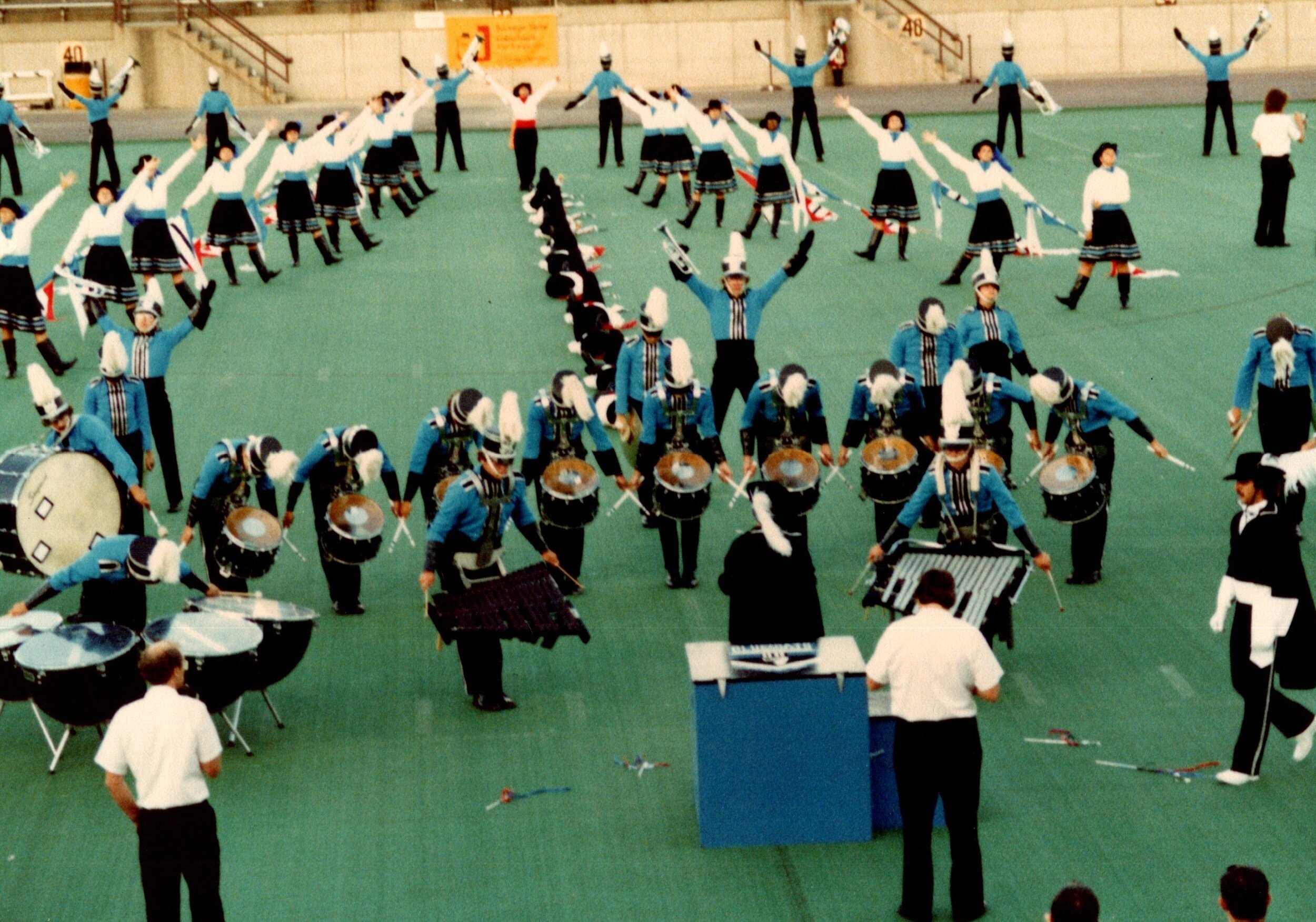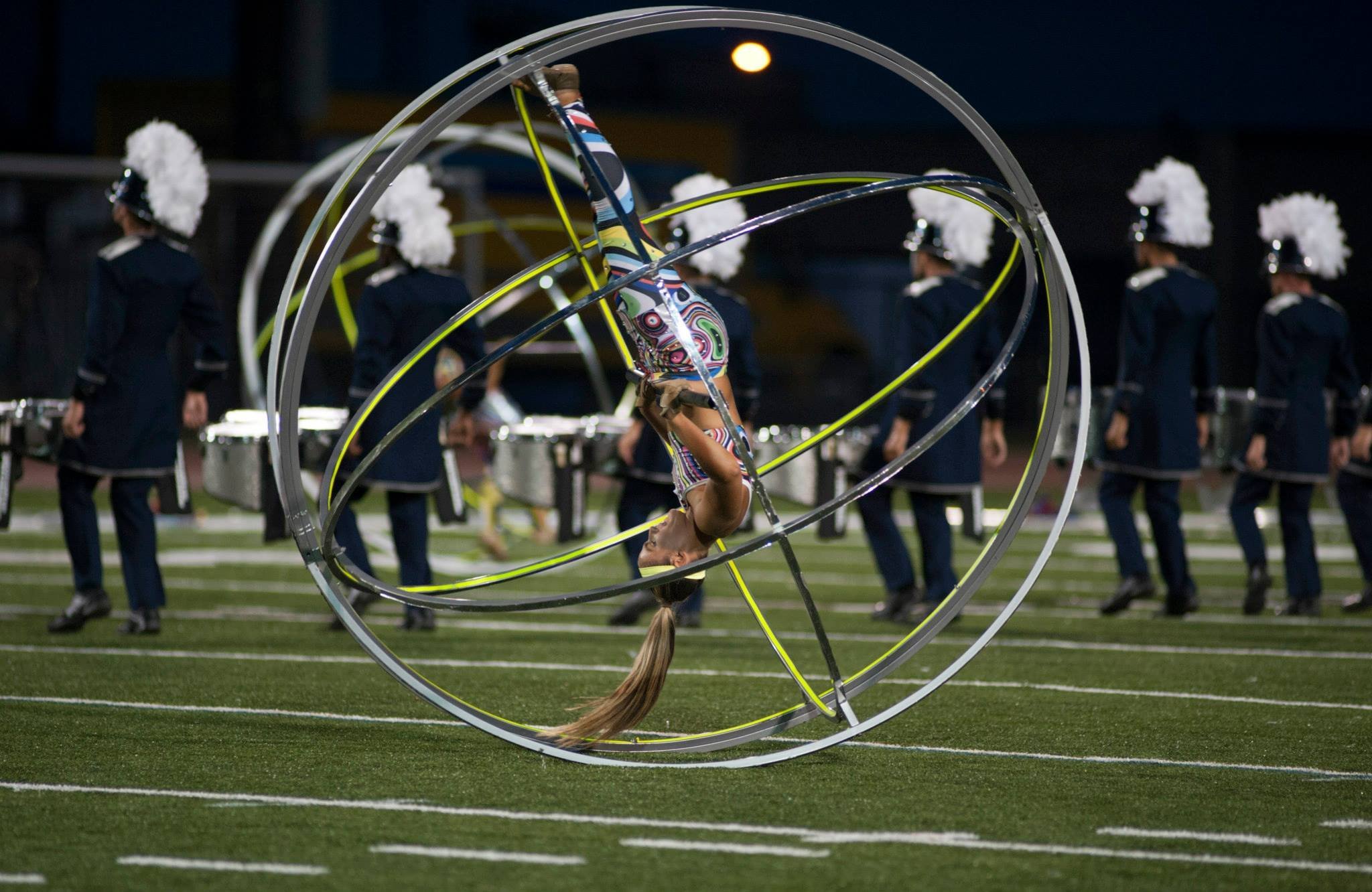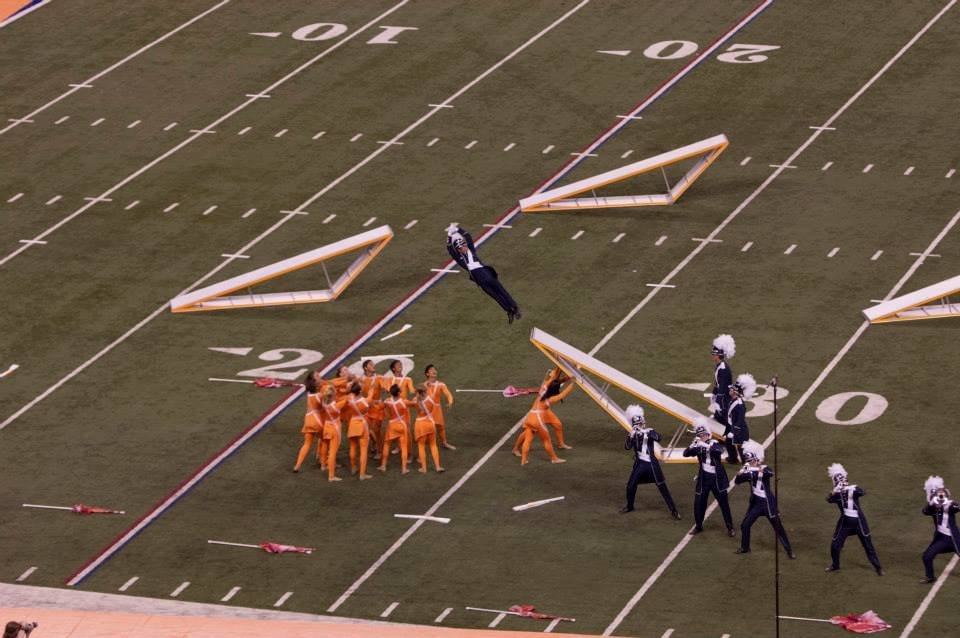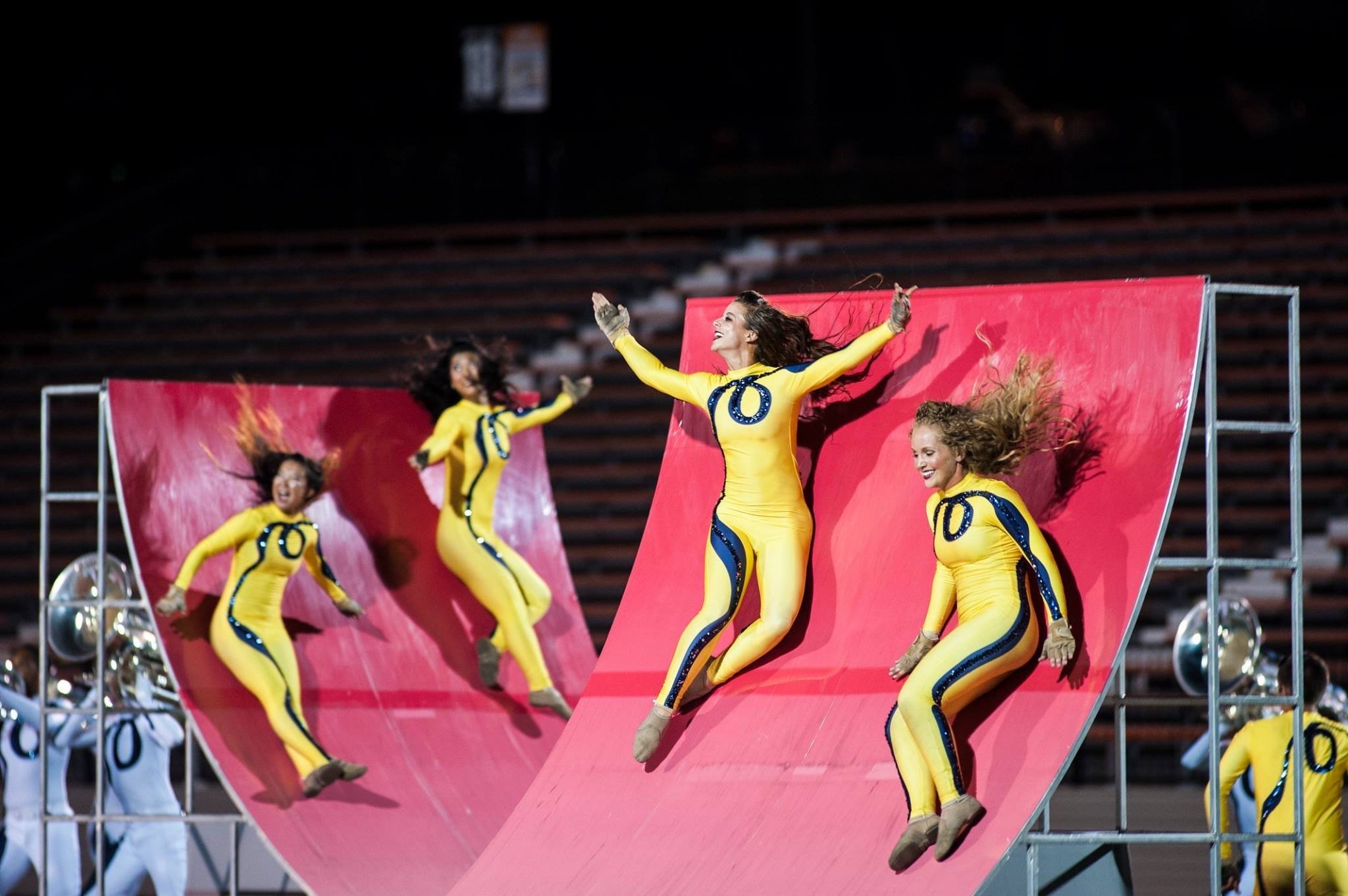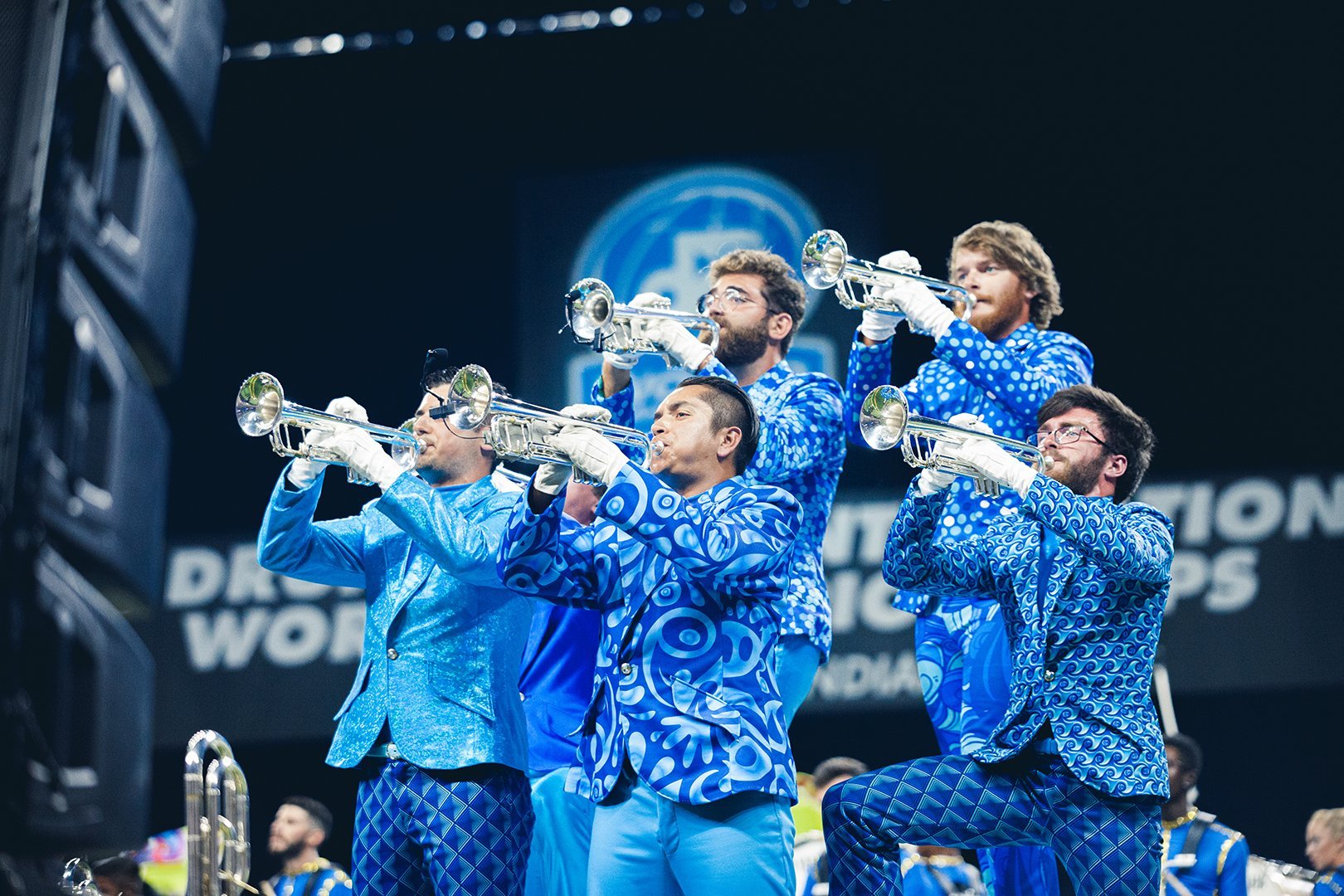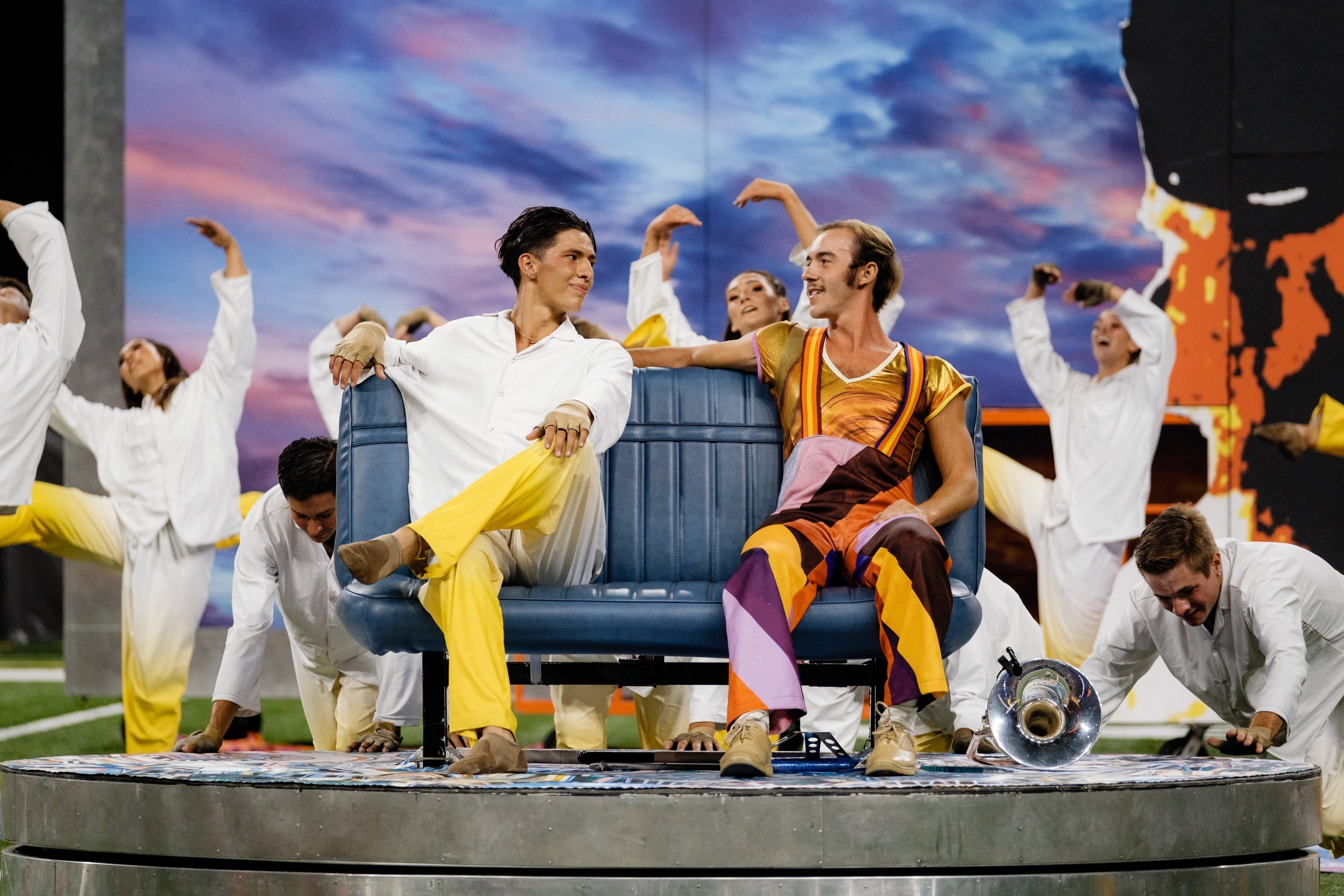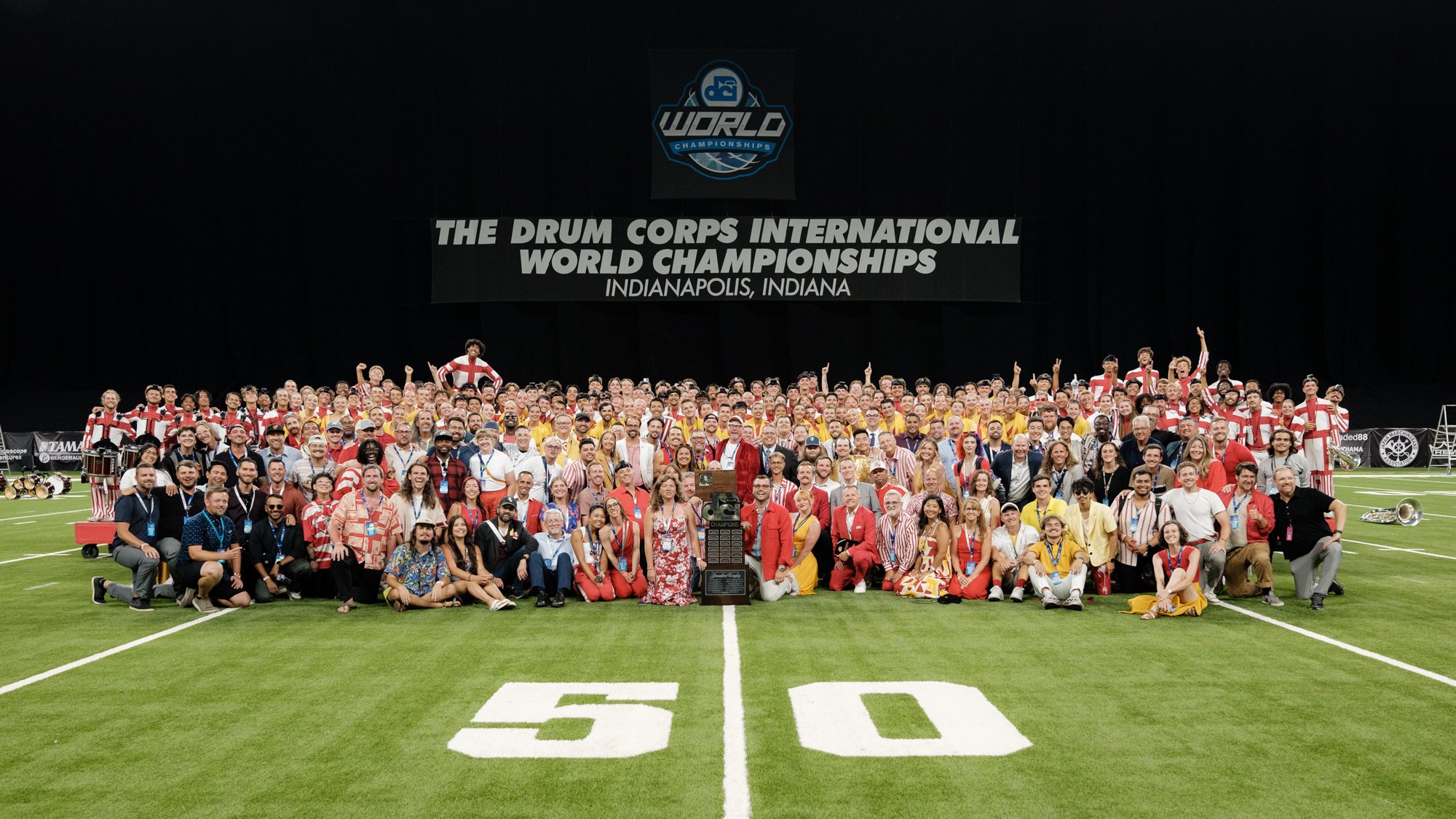
Our History
The Bluecoats were officially founded on December 3rd, 1972, but its roots had existed for years if not decades beforehand. One of the corps’ Founding Fathers, Art Drukenbrod, had been in Canton area drum corps affiliated with VFW posts. These Canton and Massillon corps were nationally renowned programs. In the late 1960s, Canton Policeman Ralph McCaulley was approached by an area band director with the idea of adding a musical group to the Canton Police Boys Club slate of activities. Ralph gained the approval of the Boys Club director, fellow officer J. Babe Stearn and the Canton Police Boys Club Drum & Bugle Corps was formed. It took the Boys Club ensemble passing Drukenbrod’s downtown Canton tailor shop for the Hall of Fame Enshrinement Festival Parade to rekindle his desire for the activity and partnership between the three was born.
The name “Bluecoats” was born in tribute to the police department’s retired police officers with a nod to its designation as a program of the Police Boys Club. The organization began in the summer of 1973 as a parade corps, then made its competitive drum corps debut in 1974 with a group of young musicians hailing from Canton and surrounding Stark County. After heading to DCI Finals week for the first time ever in 1977 and again in 1978, finances led to the corps going in active in 1979 and then again in 1983.
New management turned the corps into a more professionally touring organization and in 1987 made DCI Finals for the first time. The corps would become a fan favorite, annually landing in the lower half of DCI’s Top 12 Finalists through 1998. After barely missing in 1999, the corps has been in every Finals since. In the early 2000s the corps changed models again and installed a full-time Executive Director and a few years later added a continual revenue stream in a Bingo operation. The corps rapidly rose into the elite “Top 6” of DCI, where they remain today.
After purchasing their own building in 2011, for Bingo, banquets and the corps operations, the Bluecoats have served as one of the premier youth marching arts education organizations in the world. The corps annually hosts several educational opportunities for those not marching in the corps, have operated two WGI winterguards at various times over the past decade and manage the Cleveland Browns Drum Line. The active alumni base also operates a year ‘round ensemble as well as provides many interactive campaigns with the members of the corps, serving as a model for others to follow.
On the field, Bluecoats continue to lead in strong programs that carry broad appeal as well as high achievement. In 2010 the corps scored their first “medal” status, finishing 3rd. It would be followed by a silver medal in 2014 and 2019. Bronze medals were achieved in 2015 and 2018. And in 2016 the corps forever altered the look of the activity by shedding the traditional military-style uniforms in favor of more theatrical costuming. The show, titled Down Side Up took home the corps first-ever DCI World Championship Gold. The drum corps one its second gold medal in 2024 with Change Is Everything.
Honors
Gold Medal, DCI World Championships: 2016 & 2024
Silver Medal, DCI World Championships: 2014, 2019, 2022, 2023, 2025
Bronze Medal, DCI World Championships: 2010, 2015, 2018
Donald Angelica Best General Effect Award, DCI World Championships: 2016, 2019, 2025
John Brazale Best Visual Performance Award, DCI World Championships: 2025, 2024
Jim Ott Best Brass Performance Award, DCI World Championships: 2024
DCI World Championship Finalist: 1987 – 1998, 2000 - current
US Open Class “A” Champion: 1981
First DCI Regional Appearance: 1981, DCI North, Ypsilanti, MI
Great Lakes Drum Corps Association Champion: 1978, 1984, 1985, 1986, 1987
American International Open Class “A” Champion: 1978
Ohio VFW State Champion: 1976 -1978, 1980 - 1982, 1984
Ohio American Legion State Champions: 1976, 1977, 1981, 1982
Further History
-
After existing only as a parade corps in 1973 using borrowed uniforms, the corps began 1974 with a look based upon a Caribbean police force that co-founder Art Drukenbrod saw on a vacation. This would include the iconic helmet used by the corps throughout most of its history. By 1976, the Bluecoats toured across the country and into Canada, gaining recognition nationally as an up-and-coming organization while beginning a streak of state VFW and American Legion championships. It only took five years to win the first major championship at the nationally acclaimed American International Open in Butler, Pennsylvania in 1978.
The corps became dominant player inside the state, easily winning the VFW and American Legion state championships. To broaden the membership of the corps, the Bluecoats started running a bus from neighboring Akron to bring in more experience. Ages of those in the corps during the 1970s ranged from 12 to 20.
Around the activity, the Bluecoats were rising fast on the national scene in the Class A level. One judge even proclaimed them the most up and coming corps in the activity. Entering the 1976 season, just its third fielding a competitive show, the corps planned on debuting at DCI Championship week in Philadelphia, Pennsylvania. But it was sidetracked by an outbreak of Legionnaires Disease and the corps management made the understandable, but heart-breaking, decision to stay home. The corps would then come to DCI Championship Week for the first time in 1977, returning again in 1978. But the cross-country trek to Denver, Colorado took a toll on the organization with bus and truck issues. While achieving well for their first taste of national competition, the corps returned home in financial distress.
The corps opened the 1979 winter season with good numbers of members and fully planned to operate again, but by late winter it was apparent that the funding wasn’t there and the corps went inactive. That summer the corps still sponsored the home drum corps show, Innovations IN BRASS, and even sent a contingent of members to watch the U.S. Open in Marion, Ohio. The corps would field again in 1980, but it would be a different look and feel.
-
But the road to success had to cross a bridge over troubled waters. Twice within a five-year period, the Bluecoats were unable to field any type of performance unit. After 1979’s inactive season, the same management team attempted to piece together a corps. Lower in numbers, but not spirit, the corps hit the field with a new look. The “modern” uniform look was modeled after the new DCI Champions look, with a split jacket and dress shirt look underneath. A black shako replaced the helmet. The second year back, 1981, saw the corps taste national glory for the second time. The corps took home the Class A Championship at the U.S. Open in Marion, Ohio. While still winning state VFW and American Legion titles, the Class A championship was the lone national accolade in the first half of the decade. The same financial burdens that existed in 1979 still existed in 1983.
But it was during 1983 that the management of the corps restructured and turned to a local businessman whose son was a marching member. It would be this business savvy that would be key to the future stability of the Bluecoats. The first rehearsal in 1984 saw barely two dozen prospective members report and rather than rehearse the group played basketball. But they returned the next rehearsal with more prospects and the corps grew from there.
After the 1985 season, the corps reached out beyond Northeast Ohio to recruit new staff and membership. The move paid dividends as the corps quickly rose through the ranks. In a four-year span from 1985 to 1989, the corps bounded up the competitive ladder from 28th to 8th place in Drum Corps International Championship status. The key to the growth in the 1970s was operating an “Akron Bus” from half-hour north of Canton, bringing in new blood. The 1980s version was the “Pennsylvania Bus” and similarly infused new talent into the ranks.
The first corps from Ohio to make Top 12, the Bluecoats hit the big time with a big sound and big program. It was during this time that the signature style of the Bluecoats was born. Programming fan-friendly music with big visual effects, the corps in 1987 produced the biggest snare-line cross-sticking moment in drum corps history, with 20 snares bringing down the house. It was also at this time that the iconic “Blooooo!” would herald the corps at the end of each performance. It would lead many fans to tell puzzled first-time spectators that “they aren’t booing, they are bloo-ing.”
-
The 1990s saw the corps hit the field in three different uniforms with a wide variety of musical offerings and continual turnover of staff. The decade began with a music tribute to Duke Ellington, the first ever theme show in the corps’ history. The corps sustained its sudden rise up the ladder, holding on to 8th place at DCI Finals. But the corps would go through two new design teams in the next two years and drop back into the lower top 12.
Maintaining a world-class drum corps is no easy feat and the Bluecoats part-time approach to the management side of the organization would be tweaked several times throughout the decade. Operating on a lower-than average budget for Top 12, the Bluecoats chose to break up the Executive Director position into three different positions. Throughout the 1990s there would be turnover in several of these roles.
But as the activity evolved, the Bluecoats looked to different design team combinations in search of a programming structure that met competitive acclaim as it maintained broad fan appeal. 1991 was a throwback drum corps program, 1992 a symphonic approach to the Beatles, 1993 and 1994 a bluesy night club feel, 1995 to 1996 were patriotic-themed programs and the end of the decade a return to more traditional jazz drum corps offerings. The corps bounced around the lower top 12, finishing in each of the spots, except for 12th, between 7th and 13th.
The most remembered show of the 1990s was a tribute to America’s war Homefront on the 50th anniversary of the end of World War II in 1995, complete with the haunting presentation of a tri-folded flag from an officer to the widow of a fallen soldier resolved in the strains of America the Beautiful and the Star Spangled Banner.
-
After narrowly missing DCI Finals in 1999, the corps came out with a new spirit and dedication in 2000. The fight to get back into to Top 12 was a tight one, decided by only tenths of a point. From gaining Finalist stature again, the corps shot up the competitive ladder once again and by the half-way mark of the decade had landed in the Top 6, a feat never reached in corps history.
In 2003 the corps left behind the part-time drum corps world and hired a full-time Executive Director. It then addressed the need for a stronger financial structure by starting a Bingo operation. The corps eventually purchased its own building in 2011 for Bingo and catered opportunities, naming it the Champion Event Center. The corps also found stability in design and staffing and the continuity from a full time director paid dividends both financially and competitively.
In 2007 the corps introduced bold new uniforms, shedding the look that had been the staple of the corps between 1995 and 2006 (with minor variations). Along with the uniform change came an overhaul of the corps’ logo and branding. A new “B” was wrapped by a shield, harking back to the corps police roots at its founding.
Musically, the corps branched out to include music of all genres while keeping the signature crowd-pleasing programming in place. Shows titled Mood Swings, Criminal and Imagine depict this programming variety and style. It was The Knockout, a wide ranging musical investigation of two boxing contenders that bore the legendary Boxer shout chorus that fans flock to first rows of a stadium to hear when the corps horn line plays it during an Encore performance.
As the corps entered it’s 5th decade, the Bluecoats would land their first Bronze Medal and all time high score, all built on the work and sweat of the 2000s.
-
The 2010s marked a new era in the organization’s history where the corps was considered a perpetual contender within the activity. Between 2014 and 2019, the corps finished in the top 3 all but one time, including its first World Championship in 2016 with their entertaining and innovative program titled “Down Side Up.” On top of winning High General Effect in the Championship 2016 season, that accolade was repeated in 2019. The 2019 Championships saw the Bluecoats miss its second World Championship by a mere 0.087 points.
At the decade’s end, the Bluecoats stood atop the activity as innovators in electronics, staging and costuming. From the “pitch bend” of 2014’s Tilt, the electronic menagerie of 2015’s Kinetic Noise, sliding down ramps and the Wink of 2016’s Down Side Up to the ultimate Beatles concert experience program of 2019, the Bluecoats hit at the heart of the drum corps fan.
The organization has continued to evolve and has grown beyond operating a drum corps. The Blue Way, a two-day educational outreach program, offers prospective members an opportunity to learn and perform with the Bluecoats. In 2019 the Blue Way expanded to the Band of Excellence, which during the Pro Football Hall of Fame Festival week gives performers from marching bands across the country a chance to learn and perform at a nationally recognized event along with the Bluecoats.
In the winter of 2014, alumni of the corps, which by now numbered nearly 2,000, started a performance ensemble to give former members, instructors and volunteers a chance to perform again while serving as a promotional unit for the region. Rhythm IN BLUE continues to perform year ‘round in the Akron and Canton area.
The Bluecoats also branched out into professional sports, managing the drum lines for the NFL Cleveland Browns and the NBA Cleveland Cavaliers (through 2019). The extent of their involvement in drum lines even trickles down to the Canton area in co-sponsoring an outreach drum experience known as En-Rich-Ment for local urban youth.
In the late 2000s, the corps started a Winterguard International (WGI) regional Independent A-class guard, called Artistry IN BLUE. It was not the first such group, having briefly operated a WGI guard in 1982 (called the Bluecoats Pageantry Ensemble), but Artistry IN BLUE has earned top honors at WGI and is recognized, just as the parent Bluecoats, as one of the most creative and fan-engaging units in its activity. In 2018 the Bluecoats added another WGI unit, this one a World Class group called Bluecoats Indoors. In its short tenure, the group has boldly stretched the imaginations of the indoor pageantry activity while placing high on the competitive side.
